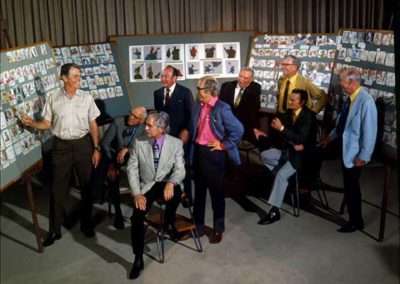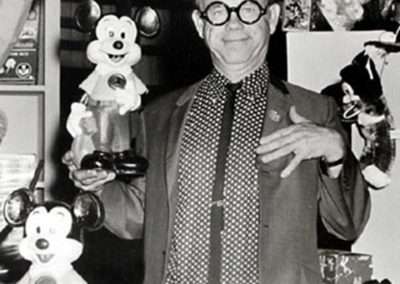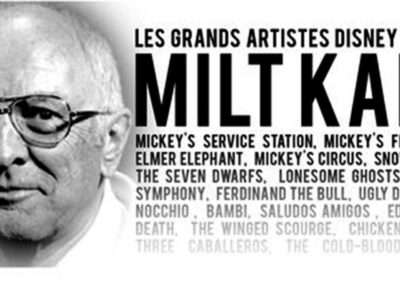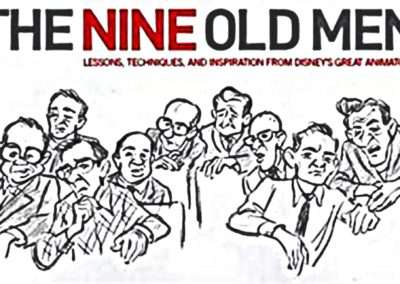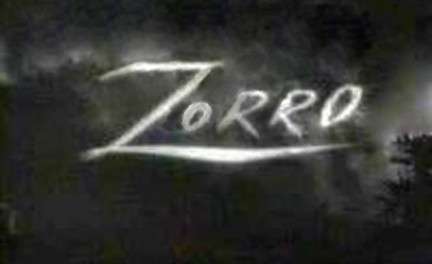The World can thank Walter Elias Disney for amazing Theme Parks, heart-warming stories and feature films, both live and animated, and his vision and innovations which has brought animation today to its present zenith. Many, if not most Disney fans and aficionados’ probable don’t know that as an artist and animator, Walt was really just pedestrian and he was the first to acknowledge it. He once quipped… “I am in no sense of the word a great artist. I have always had artists working for me whose skills were greater than my own.” He went on to say… “People still think of me as a cartoonist, but the only thing I lift a pen or pencil for these days is to sign a contract, a check, or an autograph.” To be sure, he summed it up in the most succinct fashion…”Of all the things I’ve done, the most vital is coordinating those who work with me and aiming their efforts at a certain goal.” Now this is not to infer Walt could not animate; in fact, Walt did animate much of his earlier works, notable from his “first” foray into the animation world with a company he formed called the Iwerks-Disney Commercial Artists venture with Ub Iwerks. Iwerks was a highly talented artist that was shy and reserved while Disney was a visionary idea man who was very outgoing and business minded. That undertaking lasted only a month. He then formed the Newman’s Laugh-O-Gram Film studio. Walt, inspired by “Terrytoon’s” Aesop’s Fables, Walt animated his own version of these fairytales, starting with “Little Red Riding Hood”. Puss in Boots followed, along with the Musicians of Bremen.
Walt persuaded Frank Newman, owner of three movie theaters in Kansas City to include short extracts of animation newsreels, which he called “Newman Laugh-O-grams” (A good tactical move on Walt’s part!) in his theaters. Of all these extracts of newsreels Walt animated, only one today survives…A two and half minute reel that shows the format, and the last scene which expounds local police corruption, was animated by Walt himself. It is one of the few surviving pieces totally animated by Walt himself. That is why Walt, who knew his limitations left the drawing and animation to other artists he hired over the years. He did was he did best, a storyteller and director. He was an incredible visionary who even acted out what he wanted on the screen for his animators. He was a master motivator who eked out the best in everyone.
As Walt’s studio and fame grew, his stable of talented artists and craftsmen grew. Perhaps at the time, and maybe never to be seen again, was a group of eclectic animators and draftsman working under one roof, and that roof was owned by Walt Disney. These nine core animators at Walt’s studios set the bar for animation, conceivably so high it may never be eclipsed. Walt joking gave this group the moniker of his “Nine old Men”. This amusing reference was taken from then President Franklin D. Roosevelt in his denoting to the nine Supreme Court Justices at the time, whom he believed might be out of touch with the times. Although the “Nine” were only in their thirties and forties, they were developing new techniques and innovations, and were at the vanguard of the industry. Many of the “Nine” continued on as directors at the studio.
Here are the short bios and list of these remarkable and gifted animators and the order they joined Walt Disney Studios…
Les Clark (November 17, 1907 – September 12, 1979)-Les was the first to join the studio on February 23. While in High School Les worked at a lunch counter where Walt and Roy dined regularly. There is no doubt that Les had the talent to work for Walt, but his approach to getting the job helped. One day, Les gathered up the courage and asked Walt for a job. Walt, taken a little a back, asked to see some of his work. Les admitted he copied some cartoons and showed them to Walt. Disney said he had a good line, and come to work on Monday. Four days later he started. Les is the only one of the group to work on Mickey Mouse from his beginnings with Ub Iwerks. He assisted Ub on Plane Crazy, Steamboat Willie and many of the early Mickey Mouse shorts. He moved into directing and made many animated featurettes and shorts. He started as an inbetweener and his first debut as an animator was when he animated the scene in the Silly Symphony “The Skeleton Dance” with a skeleton playing the ribs of another skeleton like a xylophone. After 48 years with Disney, Clark retired on September 30, 1975. This made him the longest continuously employed member of Walt Disney Productions. Les passed away in September 1979.
Wolfgang “Woolie” Reitherman (June 26, 1909 -May 22, 1985)-Was hired by Disney on May 21, 1933, but did not began working until June1st, 1933. He initially aspired to be an aircraft engineer, but became captivated with watercolors. He changed venues and attended Chouinard Art Institute. At the Institute, he met an instructor who taught classes at Disney’s studio. He encouraged Wolfgang to apply for a job and the rest is history. He was born in Munich Germany and his family moved to America when he was young. At the studio, he was known as the “Action Man”, with work on the Monstro chase scene in Pinocchio and the Dinosaur battle in Fantasia; and the battle between Prince Phillip and Maleficient the Dragon in Sleeping Beauty. He directed The Rescuers and Jungle Book and produced the features The Fox and the Hound and the AristoCats. Wolfgang “Woolie” retired in 1981.
Eric Larson (September 3, 1905 -October 25, 1988)- Started at the Disney Studios on June 1st, 1933 which was Wolfgang Reitherman’s starting day also. Larson attended the University of Utah for journalism, and when he became involved in the campus magazine, he found himself interested in sketching as well. After about a year after graduation, he decided to send some of his sketches to Disney on the advice of a friend and of course was hired. He started as an assistant animator on the shorts The Tortoise and the Hare and Two Gun Mickey. By 1940, he became an animation director, he designed Figaro the Cat, and animated the centaurs and horses for the Pastoral Symphony in Fantasia. He animated the Caterpillar for Alice in Wonderland and aided Marc Davis in the title character of Cinderella. His most notable animation is the flight to Neverland in Peter Pan. After Walt’s death in 1966, he was placed in charge of finding and training new talent. Because of Larson’s disposition he developed an animation training program at the studio. Some of the most talented animators attended this program…John Lasseter, Andreas Deja, Glen Keane, Tim burton and Brad Bird. Eric retired in February, 1986 after working 52 years. He was the last of the Nine Old Men to retired.
Ward Kimball (March 4, 1914 – July 8, 2002)-Ward started at Disney on April 2nd, 1934. He was inspired to animation after watching Disney’s “Three Little Pigs” cartoon. After his graduation from Santa Barbara School of Art and his hiring, Ward contributed to most of Disney’s animated films. Kimball also started as an inbetweener, working on The Goddess of Spring and Mickey’s “Orphan’s Benefit”. He also worked on Tweedledee and Tweedledum, Jiminy Cricket, Three Caballeros, the Mad Hatter and Cheshire Cat. Ward also co-wrote the script for Babes in Toyland. He produced for TV episodes of Man in Space and Cosmic Capers, and wrote and created the series, “The Mouse Factory. Another feather in his cap is the fact he helped foster Walt’s love of Steam Trains, where Walt had his own working steam train in his backyard and inspiring Walt to employ a train around Disneyland. He retired in 1972 and passed away in 2002.
Milt Kahl (March 22, 1909 – April 19, 1987)-Like Ward Kimball, he was moved to animation and working for Disney after seeing the Three Little Pigs. He started on June 25th, 1934. Kahl was considered the premium draftsman at the studio and was at his peak in drawing the human form. He started with Mickey’s Service Station and Mickey’s Fire Brigade. He worked on Snow White and the Seven Dwarfs and Ferdinand the Bull. (Which he also voiced). He was the directing animator for Lady and the Tramp and Sleeping Beauty. He was the Key animator for “The Rescuers”. He retired on April 30th, 1976 and spend the rest of his days lecturing on animation.
Frank Thomas (September 5, 1912 – September 8, 2004)-Began at Disney on September 24th, 1934. Even at 9 years old, Frank asked his dad if he could make money drawing pictures. Frank Thomas graduated from Stanford and attended Chouinard Art school. It was here that he heard Disney was hiring and his first job was the short, Mickey’s Elephant. After becoming a full-fledged animator, he worked on Bambi, Fantasia, Dumbo and Cinderella. He animated all the seven Dwarfs and the “I’ve got no Strings” sequence in Pinocchio. He also served as a directing animator for the Sword and the Stone and Jungle Book. Thomas retired on January 31st, 1978, and collaborated with fellow friend and animator Ollie Johnston with the “celebrated bible” of animation, The Illusion of Life. Frank passed away in September of 2004, 3 days past his 92nd birthday.
Ollie Johnston (October 31, 1912 – April 14, 2008)-Started at Disney on January 21st, 1935-He and animator Frank Thomas were art students at Stanford. He, as many started out as an inbetweener on Mickey’s Garden and Mickey’s Rival. One of his earliest projects was the Silly Symphonies short called The Tortoise and the Hare, which won an Oscar for Best Short Subject. Other characters he worked on… Sir Hiss and Prince John from Robin Hood, Mr. Smee from Peter Pan, the three good fairies from Sleeping Beauty and Thumper from Bambi. Johnson, like Ward Kimball also sparked Walt Disney’s love of Steam trains. In 1949, he built a 1″ scale backyard railroad, with three 1/12th scale locomotives. This was also the stimulus for Walt’s own backyard railroad, the Carolwood Pacific Railroad, which also inspired the steam train around Disneyland. Ollie retired on January 31, 1978 (along with Frank Thomas) and went on to write several books with Thomas, such as Too Funny for Words and The Illusion of Life. Ollie passed away on April 14th, 2008. He was the last surviving member of the Nine Old Men.
John Mitchell Lounsbery (March 9, 1911 – February 13, 1976)-John Lounsbery was warmly called “Louns” by his co-workers. He started at the Disney studios on July 2nd, 1935 after an instructor at the Art Center School of Design in Los Angeles arranged an interview for him with Walt Disney. He was an exceedingly strong draftsman, and his animation was known for its stretchy and squashy quality. His first assignment was assistant animator on Snow White and the Seven Dwarfs. He was then assigned to the Pluto shorts for the next few years, specializing his skill and honing his skills for future assignments. During WWll he contributed on The Three Caballeros, Victory Through Air Power and several of Disney’s propaganda shorts. He also worked on Honest John in Pinocchio, Tony the cook in Lady and the Tramp and Timothy the mouse in Dumbo. He went on as directing animator for Winnie the Pooh and the Blustery Day, Winnie the Pooh and the Honey Tree. The Blustery Day won an Academy Award. John was hard on himself, undervaluing his own ability, despite inspiring many of his fellow animators over the years. John animated at the studios until his passing on February 13th, 1976. John was the first of the Nine Old Men to pass away.
Marc Fraser Davis (March 30, 1913 – January 12, 2000)-Marc started at Disney on December 2nd, 1935. Marc had no formal or background training in animation. At first, he was searching for a job as a cartoonist when he heard that Walt Disney was hiring. After seeing Marc’s sketches of animal anatomy and their movement, he began as an apprentice animator on Snow White. Marc Davis is credited with the creation of some of Disney’s most famous villainesses and most popular fairy, Tinker Bell. Maleficent in Sleeping Beauty and Cruella De Vil in 101 Dalmatians are how Evil foils are measured. Marc also is the major contributor in classic Disneyland ride attractions; It’s a Small World, Pirates of the Caribbean, the Jungle Cruise, The Haunted Mansion and the classic Enchanted Tiki Room. He was placed in Disney’s design and development organization, the forerunner of Walt Disney Imagineering. Marc’s wife Alice is credited with designing the costuming for Pirates and the child dolls in It’s a Small World. Marc Davis was the last of the Nine to be hired, and after 43 years, he retired in 1978. He once said about working at Disney…”There was competition, but it was an odd kind of competition. I’ve said before in a joking manner that Walt Disney’s greatest achievement was in getting us all to work together without killing one another!” He continued to advise in the creation of Tokyo Disney and EPCOT. He passed away January 12th, 2000.
In addition, the Nine Old Men wrote the “Commandants” or basic principles of modern animation…Anticipation, Staging, Straight Ahead Action and Pose to Pose, Follow through and Overlapping Action, Slow In and Slow Out, Arcs, Secondary Action, Timing, exaggeration, Solid Drawing and Appeal. This group of animation giants gathered together when animation was basically still in its infancy. With Walt at the helm, they created techniques and devised methods that today are still used in our computer-generated movie society today. This is not to take anything away from today’s CGI artists, in fact Walt himself, who loved progress and innovation would have embraced this new technology, where a mistake or a change is as easy as a few keystrokes or movements of the mouse.
There is just something missing, at least for many animation purists who embrace the 2D form of animation. It seems the animators of old were more “Involved” in the creation of their craft; drafting 24 scenes to make a second of movement, all without the aid of the computer. It is akin to many audio purists today who prefer vinyl records to CD’s and MP3’s. It has been more than 41 years since the first of the Nine to pass, and I’ll wager that the majority of today’s Disney fans would not recognize most of the Nine’s names. But all fans of Disney, animation and movies have these pioneers to thank for the advancements we enjoy today. We have come a long, long way since Gertie the Dinosaur!





